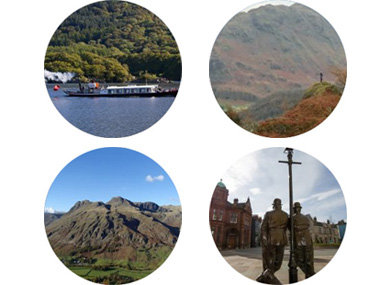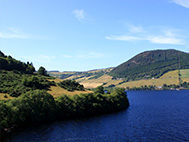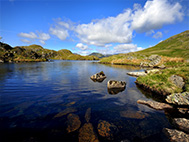| |
August Newsletter
from Contours Walking Holidays

Welcome to the August edition of the Contours newsletter; bringing you the latest stories, advice and information all about our magnificient UK walking trails!
This month we have an insightful article from Nicky Jacquiery offering advice for new walkers considering their first long-distance walks, and Beth Pipe returns with her pick of five great things to see along the Cumbria Way. As well as this, we have packed in a variety of interesting facts and our usual 'Guess Where?' competition, where you can win £10 off your next Contours Walking Holiday!
Thanks for reading and happy walking!

Five Great Things to See
Along the Cumbria Way
By Beth Pipe
The Cumbria Way winds its way from Ulverston to Carlisle and the entire route is awash with breathtaking scenery, but here are five nuggets of history to look out for along your way:

Continue reading ...
Do you have an idea, article or account of your walk that you would like to share? Send an email to newsletter@contours.co.uk to contribute to our newsletter.
Getting Started – Walking for Beginners
By Nicky Jaquiery
Summer has finally arrived! The weather is better and the days are longer, so it’s a good time to think about some walks that you might like to do. If you’re a novice and have never really considered walking, now is your chance to give it a go. It doesn’t matter how old you are or how fit you are, anyone can walk; plus it’s good for you, it’s sociable and best of all, it’s free!

I’ve been walking for many years now. I started walking as a child on family holidays and then completed my first long-distance walk, the Coast to Coast, with a friend when I was 16 years old. I’d just finished my O-levels (which gives you an indication of how old I am!) and I can still remember the sense of freedom I felt when my Dad dropped the two of us off at St Bees and waved us goodbye. Setting out on a walk across England was a huge adventure to me back then. You may not be thinking of walking across England just yet, but there is nothing to stop you from going for a shorter and less demanding walk. Whilst it may seem daunting at first, all that’s needed is a little preparation and you’ll be ready to go. To help you, I’ve put together my ideas for getting started and included some hints and tips, so that you don’t make the same mistakes that I have!
Continue reading ...
Tree of the Month - Silver Birch
(Betula Pendula)
With Kevin Parr

CC Taken by Khawkins33
In his 1802 Romantic work The Picture, or The Lover’s Resolution, Samuel Taylor Coleridge finds himself beneath a “weeping birch”. He calls it the “most beautiful of forest trees – the lady of the woods”, and it is hard to disagree. There is a fragility to a birch tree; not just in the flaking bark that cracks and peels like varnish on the weathered hull of a boat, but also the delicate branches that tremble in the softest breeze.

CC Taken by Dean Morley
On a dank winter day, the trunks shimmer through the mist like the stretched ghosts of old foresters. And even in summer, with the tree in full leaf, the trunk remains distinct. The leaves of a birch are small but vibrant; bright green emeralds glistening against grey.
They still hold their colour in August and remain sparce, allowing plenty of light to reach the forest floor. Here, smaller plants can find room for their own growth, though in late summer it is fungi with which the birch is often associated.

The silver and downy birch, which are both widespread, are well regarded by mycologists – especially those looking for an edible treat. The acidic soil in which they thrive provides good ground for some of our most iconic mushrooms. Ceps, orange birch boletes, chanterelles and fly agaric all flourish beneath the birch, especially when the tree is a dominant species within a mixed woodland.
As the leaves begin to brown and fall, finches fill the branches to feed upon the tiny winged seeds. There is little commercial value in the wood, but this is a tree long associated with fertility. In the Highlands, it was once believed that an unbearing cow could be made fertile if she was herded with a branch of birch.
Featured Posts
Walking Sticks in History & How to Make One Yourself

“Crafting a stick this way results in an incredibly strong and 100% natural cane.”
– Ben Law, Woodsman.
Read more...
Previous Newsletter

Last month we brought you an informative review of walking boots by our regular contibutor Damian Hall, as well as a first-hand account of the magnificent Fife Coastal Path by Ben Taylor. We also had lots of great news, fascinating tibits and enticing competitions all packed in for you to enjoy at your leisure. Thank you for reading and happy walking!
Read more...
| |
What is Mountain Rescue?

CC North West Air Ambulance
Mountain rescue in England and Wales comprises 48 teams in nine regions, as well as five specialist groups that handle trained dogs. They work under the auspices of the police and are called out through the 999 system; they will often work or liaise with the statutory emergency services, as well as Air Ambulance and Royal Navy helicopters and HM Coastguards. Scotland has 24 teams, two search and rescue dog associations, Scottish Cave Rescue, three police teams and an RAF team. All mountain rescue organisations are volunteer-based and rely on charitable donations and bequests.
Did you Know?
Owls cannot actually turn their heads all the way around. Although it looks like they can, an owl’s neck actually only rotates about 135 degrees in either direction from facing forward, giving them a still-impressive total of 270 degrees of movement.

CC taken by Marie Hale
Owls have a number of special qualities to enable them to achieve this great range of rotation. Firstly, owls have 14 vertebrae in their necks, twice the number of the average bird, however they have many more adaptations besides this to allow them to survive twisting their necks to such dramatic extents. They have alternative blood vessels running into the head, as well as blood pooling systems to keep the blood circulating when their neck movement cuts off the circulation, and even special air-cushioned vessel casings so they don’t rupture a blood vessel when snapping their head around quickly.
Why Walk?

Your heart is a muscle and it needs physical activity to stay in good condition. Regular walking can help to give your heart the workout it needs. Being active helps reduce your risk of developing coronary heart disease. Walking also helps reduce your risk of suffering from a stroke, type 2 diabetes, obesity and osteoporosis.
If you’d like to know more about how walking can help, you can order a "Put Your Heart Into Walking" booklet at the British Heart Foundation website.
Last Month's 'Guess Where?'
The shot from last month's 'Guess Where' proved to be a bit difficult, as no one was able to identify the freshwater loch in the Scottish Highlands, Loch Ness, as seen on the Loch Ness Round.
 (click image to zoom) (click image to zoom)
To be in with a chance of winning a £10 Contours Walking Holidays voucher, why not try this month's 'Guess Where?' below!
Competition Time: 'Guess Where?'
To win this month's competition, can you identify this tarn?
 (click image to zoom) (click image to zoom)
The first correct answer will receive a £10 Contours Walking Holidays gift voucher. Good luck!

|
|